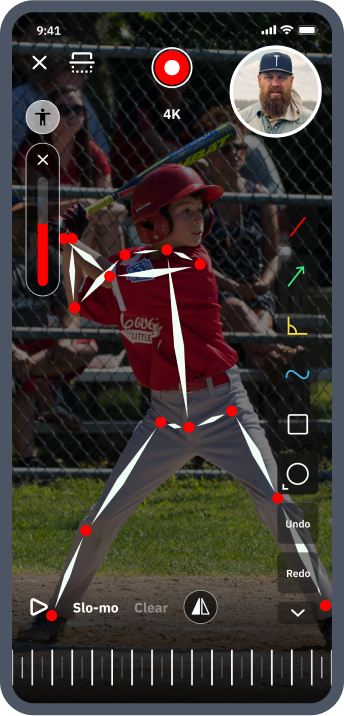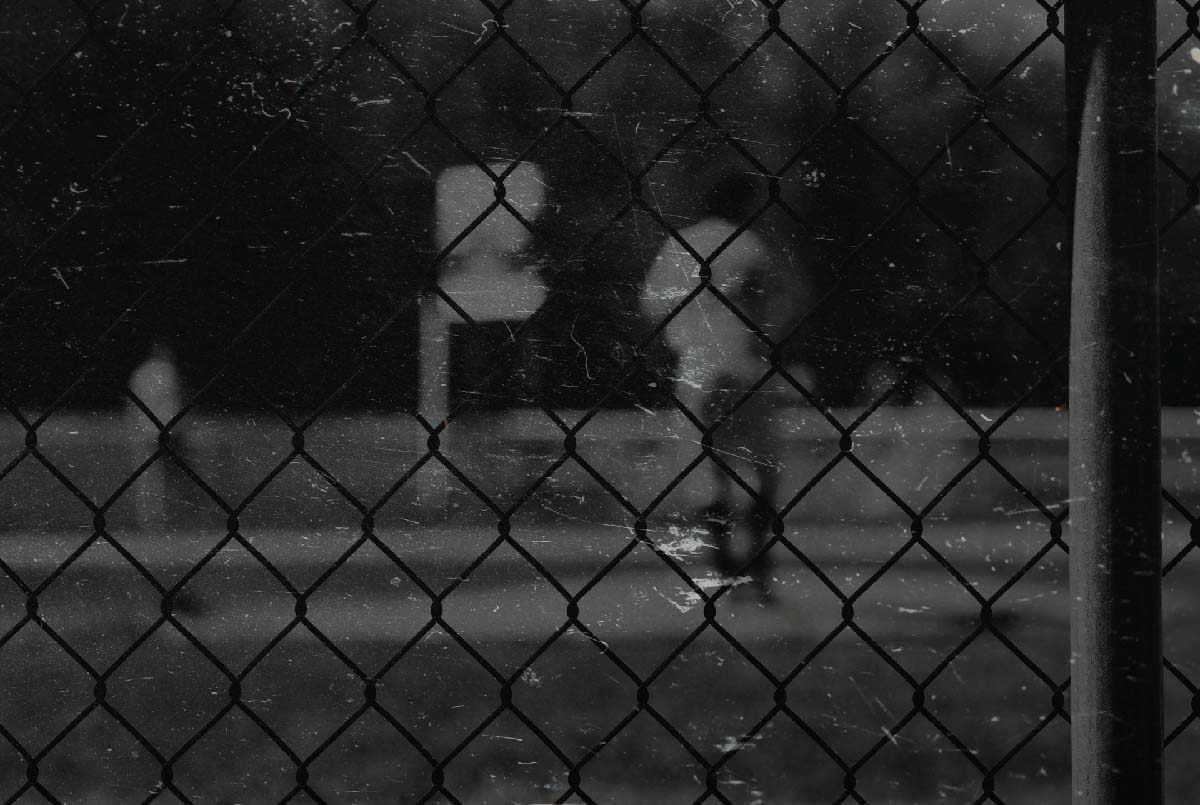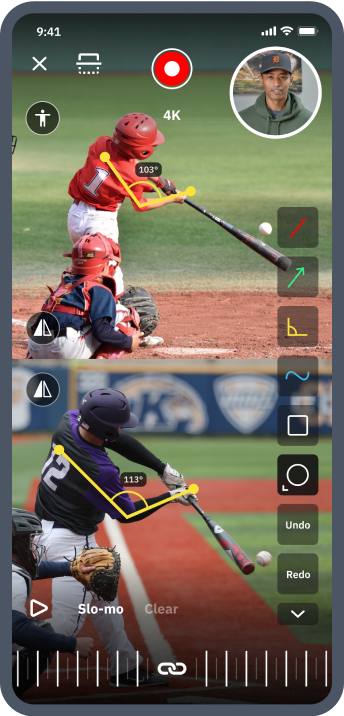How Mobile Learning for Baseball & Softball May Be the Secret to Growing Your Game | The Science Revealed

You can’t go to a local field these days without seeing parents in the stands filming their son or daughter’s every at-bat.
And almost every lane at the neighborhood batting cages either features a hunched-over parent trying to capture a video through the holes in the net or young ballplayers recording dances with their friends for TikTok.
With this proliferation of mobile devices in our daily lives, it seems inevitable that educational content would follow suit.
Mobile learning, which just refers to learning on a mobile device, has thus become hugely popular in recent years across all sorts of industries.
Though learning on mobile devices has had proven results in offices and classrooms worldwide, it’s also earned a powerful place in the games we love – baseball and softball.
We’ll go deeper into mobile learning, its development over time, and how massively it can impact ballplayers and coaches alike.
What is Mobile Learning for Baseball and Softball?
According to expert researchers Claire O’Malley et al., mobile learning is:
Any sort of learning that happens when the learner is not at a fixed, predetermined location, or learning that happens when the learner takes advantage of the learning opportunities offered by mobile technologies.
Mobile learning can take place across many different contexts, where learners can interact with each other as well as the content they’re consuming.
This practice has been used for years to supplement traditional learning in classrooms and by busy professionals in numerous corporate settings.
But with the current prevalence of video courses and social media instructional coaching content in our games – not to mention actual remote private lessons – mobile learning certainly applies to baseball and softball.
Learning and development researchers have long-pointed to the potential of mobile learning to upend traditional education models across disciplines.
As we’ll see in just a bit, technological advancements have been developing in tandem with breakthroughs in neuroscience, psychology, and educational science.
These diverse disciplines and endeavors all working together are what makes mobile learning so effective for baseball and softball athletes.
So let’s start by briefly introducing some of the tech, terms, and concepts that modern parents, ballplayers, and coaches should become familiar with.

Mobile devices
Mobile learning would not work, of course, without mobile devices. The introduction of cell phones and later smartphones revolutionized daily life for people around the world.
For many of us, it’s almost unthinkable to leave home now without our smartphone.
Mobile learning doesn’t fight or shy away from this new reality, as it’s designed specifically for mobile delivery.
Mobile learning also progresses the use of technology in education forward.
Mobile phones are usually more accessible and less expensive than personal computers or laptops, plus they can travel outside the classroom or home.
Smartphones, therefore, have become a more appealing choice for both teachers and students across disciplines.

Microlearning
A crucial concept linked to mobile learning is called microlearning.
These short-term lessons with small learning units, are typically designed for use on, you guessed it, smartphones, tablets, or other mobile devices.
According to scholars S. Gabrielli, S. Kimani, and T. Catacri, microlearning is:
Based on the idea of developing small chunks of learning content and flexible technologies that can enable learners to access them more easily in specific moments and conditions of the day, for example during time breaks or while on the move.
The overlap with mobile learning is clear.
Microcontent is designed to be accessible anywhere, at any time of day. It’s also geared toward individuals who want informational content on a specific subject, rather than access to a whole body of knowledge in a given field.
We’ll return to microlearning and how it applies to ballplayers a bit later in this article, but you can read much more about it and its scientific basis in Microlearning: The Proven Science Behind Remote Baseball & Softball Lessons.
Video feedback and analysis for baseball and softball
The fact that nearly everyone now has a professional-grade camera and high-powered computer in their pocket at all times has increased the options that ballplayers have to learn and retain skills.
This partly explains why the professional and self analysis of game and practice footage has assumed such a prevalent place in baseball and softball player development in recent years.
But the other reason that video analysis and feedback – often delivered as mobile learnings through software platforms and applications – have taken off in our games is because they actually work amazingly well to accelerate progress.
With video analysis, learners can watch themselves perform a skill – like hitting or pitching – at a distance giving them an instructor's outside perspective on their actions.
And this perspective shift alone can be a huge unlock for athletes toward accepting weakness, discovering strengths and pinpointing movement inefficiencies.
Video analysis tools also allow ballplayers to compare their swinging or pitching mechanics to top MLB or collegiate players in seconds and quickly spot areas for improvement.
This same technology lets coaches pause, re-play, and literally and figuratively slow down their real-time perceptions of an athlete's movement patterns.
These capabilities help our game’s experts reevaluate what’s happening using more complete and objective insights, with less room for human perception errors and biases – which we all have.
Believe it or not, this is all still just the tip of the iceberg on how mobile learning with video analysis and feedback can make a ballplayer’s journey more productive and skyrocket the effectiveness of both in-person and online coaches.
But let’s move on to the next phenomena enabled by mobile learning efforts.

The spacing effect and delayed learning
Just like microlearning, the spacing effect and delayed learning are also almost inextricably linked to mobile learning these days.
In fact, they are two of the beneficial by-products that often come from mobile learning scenarios.
In other words, if you study for an hour every day as opposed to cramming four hours of studying into one day, you're more likely to remember the material.
This is because spaced practice leads to more opportunities for retrieval practice, which strengthens the memory trace.
Similarly, delayed learning challenges the commonly held idea that immediate feedback is always best.
A small part of the thinking behind delayed learning is that it can take time for learners to really process and digest what they've just learned, and so immediate feedback might sometimes be premature.
But the real unlock in this approach is that immediate and constant feedback leads many learners to engage in simple rote memorization.
When learners are fed answers to memorize, they never really interact with the material, which stifles them from ever achieving a deeper understanding of it.
Instead, delayed feedback allows for baked-in reflection and metacognition, AKA thinking about one’s thinking, which can lead to a stronger understanding and long term retention of any new material – including baseball and softball instruction.
Both spacing effect and delayed learning are based on sound psychological principles and have been backed up by copious research.
And both these concepts leave room for ballplayers to take meaningful ownership of their own developmental process in the game and this can make all the difference in enabling and cultivating success.
Here's exactly how and why it works.
Let's say a ballplayer records a video of themselves doing tee-work.
The player is filmed both from the side and back and is intentionally trying to show in each swing that they have internalized the feedback from the last online lesson with the same coach.
The player sends the video footage and waits for the coach's lesson feedback to come back.
This interruptive wait allows room for the ballplayer's mind to think more consciously about what they sent over to the coach and about their swing writ large.
This current iterative loop closes when they receive the coach’s feedback.
Now the player has new concepts, mechanics, and cues to internalize in the delayed wait between filming and sending the next lesson.
Unlock your ballplayer’s full potential
Find the perfect vetted coach to build a solid foundation or take your player's skills to new heights.
Download the free app

The rise of remote coaching in baseball and softball
Global Workplace Analytics found that between 2005 and 2019 the remote workforce had increased by 140 percent.
Then the pandemic came and poured rocket fuel on this already growing trend toward remote work.
And this remote work macro trend has coincided in a huge way with the meteoric rise of what experts call “the creator economy.”
When such a “creator” is baseball or softball expert, we are partial to term “Coachpreneur” instead.
But semantics aside, the combined growth of remote work and creators has led to more mobile lessons, courses, and social content for coaches to offer clients and customers.
Which, in turn, means significantly more opportunities for baseball and softball players and their parents to consume elite mobile learnings on their phones or tablets.
If you want an in-depth look at the current state and major benefits of remote coaching and online instruction, don’t miss our full report.
The History and Development of Mobile Learning
Mobile learning has also developed alongside larger theories of education more generally.
Mobile learning is inherently learner-focused – emphasizing the learner’s active role in their process of knowledge acquisition and improvement.
The development of mobile learning can, therefore, be traced back to the proliferation of learner-based pedagogies and theories in the 1970s.
It was at this time that education scholars and researchers started finally realizing how vital active participation is to the learning process.
In the following decades, learning and development specialists built upon this active participation approach.
The 1980s saw a focus on interactions with the environment or gaining knowledge through creating social objects.
In the 1990s, there was a shift toward authentic skills-based learning – which meant teaching a particular skill in the environment that the learner would use it in.
This decade also brought us the idea that knowledge is constructed interdependently, meaning through an individual’s interactions with others and with their environment.

Technology and education develop in tandem
These shifts in learning pedagogy set the stage for mobile learning, which took off, unsurprisingly, around 2007 – which is when the first Apple iPhone was released.
Some researchers argue that mobile learning is the result of technological influence on education.
While technology undoubtedly has an impact on how people learn, other scholars, like Mike Sharples, propose that:
There is a mutually productive convergence between main technological influences on a culture and the contemporary educational theories and practices.
Basically, education and technology influence and benefit each other.
Education responds to developments in technology and some technological advances are aimed at improvements in learning.
Indeed, as researcher Helen Crompton points out, in the 1990s, “technologies had become more advanced, personalized, and novice-friendly” to exactly parallel the learner-focused educational models popular at the time.

Mobile learning has become indispensable in education
The idea of mobile learning was preceded by eLearning, which was first described as teaching and learning supported by electronic media and tools.
The definition of eLearning has expanded, however, to better reflect everything possible when applying digital tools to education.
Students can now write a collaborative essay on Google Docs, or define a novel concept amongst a community on a wiki.
Fully-online courses also developed and, for many, these formal educational courses delivered at a distance are what encapsulate eLearning.
Mobile learning was simply the shift of eLearning toward mobile devices.
When smartphones were released, they showed a greater capability to handle learning modules than their PDA predecessors.
And as smartphones and tablets became more powerful in terms of processing and more common – to the point that everyone over a certain age has a personal mobile device – educational institutions saw the opportunity for cost-effective mobile learning implementation.
Around 2005, mobile learning platforms and applications started becoming ubiquitous. In 2019, the global mobile learning market was valued at $27.32 billion and is projected to reach $280.08 billion by 2027.
The two biggest markets served by mobile learning are corporate and academic, but mobile learning can apply to everyday situations and absolutely expand to athletics like baseball and softball lessons.

The Proven Science of Mobile Learning
Mobile learning is also growing so much because it actually improves learning outcomes.
People are more than willing to consume educational content away from a classroom or an office, if it’s accessible and enjoyable.
In a survey, the eLearning Industry found that, given the choice of access methods, 76 percent of people completed modules away from their regular place of work, and 66 percent completed modules at home.
Shifting learning modules to a mobile app also increases the chances learners will complete a course.
Apps use notifications, which have a 97 percent read rate. By contrast, email messages only receive 5 percent.

Mobile devices are more accessible
Another reason mobile learning is so successful is, of course, because mobile phone use is so widespread.
The average person spends two hours and 51 minutes on their smartphone each day, looking at it roughly 221 times and touching the screen more than 2,600 times.
In addition, 65 percent of all digital media is viewed on smartphones.
Eighty-nine percent of smartphone users download apps, half of which are used for learning.

Mobile learning improves productivity
In addition to being more accessible, mobile learning produces more productive learners.
Smartphone learners complete course material 45 percent faster than those using a computer.
Mobile courses might be completed more quickly because people like them better.
In fact, 70 percent of learners said they felt more motivated when training on a mobile device as opposed to a computer.
Mobile learning is better for retention
The format of mobile learning modules – often delivered as microcontent – enhances retention, which is the ability to keep something in one’s memory. Bad retention equals bad learning.
In a study on mobile learning, researchers asked some participants to attend a live lecture and others to listen to a podcast via a mobile device.
The podcast-listeners, on average, scored higher on a subsequent comprehension assessment than the group of live lecture attendees.
In this study and others like it, those engaged in mobile learning displayed significantly better knowledge retention than others.
Mobile Learning and Microcontent for Ballplayers
One of the biggest keys to mobile learning’s success is the format of the courses.
Delivered as microcontent, or small lessons of no more than 10 minutes, mobile learning modules are completed quickly.
Learners no longer have to set aside special time for courses or picking up a new skill. They can access microcontent anywhere and anytime with their mobile device.
Long-form courses aren’t as well suited to mobile devices, which have small screens and a user interface designed for short periods of use.
Well-designed educational microcontent, on the other hand, doesn’t require smartphone users to stare at their device for too long.
The microcontent available in mobile learning modules is also effective for what experts call “just-in-time learning.”
This type of learning environment is also convenient for baseball and softball players, who can quickly pause their hitting or pitching training workout to access the instructional content they need through mobile.

But microcontent and just-in-time learnings are not exclusive to online video courses – they can also be found in certain types of online private lessons.
For example, if a player sends coach footage of their swings from practices or games and that coach uses advanced analysis tools along with their lifetime of expertise in the game to break the hitter’s swing down in a short, personalized feedback video.
Such a scenario would allow a ballplayer to apply this powerful just-in-time learning effect by watching their remote lesson feedback right before their next big game or tryout.
The small chunks of information in microlearning courses or 1:1 lessons are also better for overall learning.
The science behind microlearning is based on the human cognition theory, which states that information processing takes place in short-term memory.
Consuming information in smaller bits is, therefore, supposed to align better with how we learn best.
If you’re interested, an additional concept related to this science of learning and skill retention for ballplayers is the Zeigranik effect.
Why microlearning is successful
Researchers Peter Bruck, Luvai Motiwalla, and Florian Foerster carried out a study of mobile learning and microcontent using a personalized learning solution.
In their study, they identified some main characteristics of microlearning that make it both successful and compatible with mobile learning:
- Repetition of the education content
- Assessment at the end of each unit
- Content organized in hierarchies, making information easier to find
Their findings also reflected what learning and development researchers have stated about learning models since the 1970s.
The analysis from the Bruck, Motiwalla, and Foerster study shows that learner-focused education might be more beneficial to students and that microcontent delivered via a mobile device expertly achieves this approach.
How Mobile Learning Works for Baseball and Softball
It’s clear mobile learning has implications in the corporate and academic worlds. And, hopefully, it’s also clear now how and why passively consuming baseball or softball video courses or social media educational content can be helpful for our athletes.
But what about actual remote baseball and softball lessons? Is delivering pitching or hitting lessons via bite-sized chunks effective?
The evidence behind mobile learning and its related phenomena points to an emphatic yes.

Remote baseball and softball lessons have become more popular in recent years, as technology allows coaches and instructors to connect personally with athletes all over the world and scale the knowledge inside their heads like never before.
As a parent, you’re no longer limited to the pitching or hitting instructors in your local area. You can search for remote lessons, from top coaches who might be a better fit for your athlete’s particular needs.
But when it comes to such distance learning, not all baseball and softball lessons are the same, however. You’ll have to decide which format you and your athlete prefer.
Do live streaming call sessions work better for your young hitter? Or maybe, it’s a coach sending your ballplayer video feedback and analysis of their swing footage?

Personalization is also the key unlock for any of these lesson types – 1:1 instruction with your favorite former MLB player or the coach of your dream college makes all the difference in your ballplayer’s retention and accelerated progress.
As does the ability to re-watch lesson insights over and over in a way that’s almost impossible with traditional in-person lessons which are usually not filmed in their entirety.
And, also in accordance with mobile learning principles, every lesson should be saved forever in a personal library, so ballplayers can refer back to hierarchically organized and bite-sized learnings and insights anytime – like before that big game or try-out.
With apps like ours, you have the option to find a remote baseball or softball instructor delivering any type of lessons you’re looking for.
Check out all the options here. {link internally to For Players page of website}
Regardless of the context or platform, we wish you and your athlete happy mobile learning in the years to come.
Unlock your ballplayer’s full potential
Find the perfect vetted coach to build a solid foundation or take your player's skills to new heights.
Download the free app

About the Authors
Courtney Withrow
Professional Writer
Originally from the U.S., Courtney is a Brussels-based freelance writer with a Master’s degree in International Relations. She grew up playing softball and still loves the game.
Mike Rogers
Co-Founder & CEO
Mike Rogers has spent a lifetime entrenched in baseball and softball as a player, a private instructor, a training facility owner, and the son of two college-level coaches.

